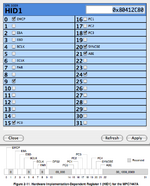Thanks
@herd. Appreciate your insights and opinions - however I did ask specifically about “
stock” 1.33 GHz G4 minis and not for any G4 Minis “set” or overclocked to 1.33 GHz. Perhaps additional clarification was necessary?
The 1.33 GHz model AND the 1.5 GHz are members of the 10,2 Family - while the 1.25 & 1.42 GHz were from the earlier 10,1 Family. The 1.5 GHz model featured the increased VRAM of 64 MB (over all others @ 32 MB VRAM).
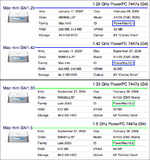
And my inquiry here (and elsewhere) pertains primarily to many of those oveclocking guides that you mention
and as to whether or not the stock 1.33 GHz version was originally produced
without the R52 resistor... that
those guides note need be removed to attain 1.33 GHz. Now, that
might be because the guides apply
primarily to the 10,1 family… but that is partially what I am also attempting to clarify. *One might note too that the settings for many of the overclock speeds above 1.58 GHz also note the removal of R52?
(Perhaps in a related vein, in order to downclock a 1.42 GHz mini to 1.33 GHz - would one need to remove the
R52, R351 and R355?)
Inset images below are from a 1.25 GHz G4 Mac mini.
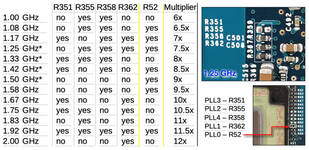
Unfortunate that you can’t view any pictures on MacOS9Lives.com - but that is possibly, easily remedied by registering with the site much as one registers here or over on MacRumors, Tinker Different, etc. There is no fee.
In recent testing here, a distinct difference in air exhaust temperatures was discovered with TWO of seven minis. (All stock, none overclocked and including 1.25 GHz, 1.42 and 1.5 GHz. Sadly, no 1.33 GHz.) Keeping in mind that the TWO minis (a 1.42 GHz and a 1.5 Ghz) both still had the paper thin, black, original heatsink thermal pad in place. Eighteen (nineteen?) year-old machines that had never had those pads renewed, removed or thermal pasted. The five other minis here (all upon cold boot) registered initial exhaust temps of 84˚F in the first minute or so. After ten to 15 minutes those temps rose to and remained steady @ right around 100˚F (at idle). The TWO minis that still had their original black thermal “pads” quickly rose to and measured 107˚F to 112˚F …within the first 10 minutes, after dead cold boots.
Then, after removal of the original thermal pads and application of fresh thermal paste (Arctic Silver) those TWO minis registered exhaust temps just like the other five. Perhaps a valid question here is: what computer is expected to continue to run for 18 or 19 years without ever having had fresh thermal paste applied and/or thermal pads replaced?
Now granted, some may take a look at those spring-loaded heatsink retainer pins and opt out of proceeding any further. [ Pin removal is also covered here:
http://macos9lives.com/smforum/index.php/topic,6875.0.html ] Alas, registration required to view images.
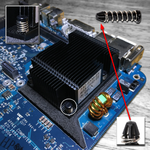 “I got one Mini that would always run with a very fast fan. I opened it and found the heatsink and fan filled with cat hair. Once cleaned, the fan ran much slower (while the CPU may be be around the same temperature and the air coming out the back is likely hotter).”
“I got one Mini that would always run with a very fast fan. I opened it and found the heatsink and fan filled with cat hair. Once cleaned, the fan ran much slower (while the CPU may be be around the same temperature and the air coming out the back is likely hotter).” - herd
Was a new thermal heatsink pad or thermal paste applied?
Do you still have that machine and if so, what is its ”idle” exhaust temperature after a cold boot and 10-15 minutes, now?
And also granted, if your testing environment’s temperature is very high, temperature ranges may indeed vary somewhat.
Here are some temp readings from a very recently deceased (not mine) 1.42 GHz G4 Mac mini:
• 1 min. bottom: 30ºC / 86ºF
• 4 min. bottom: 38ºC / 100ºF
• 15 min. bottom: 41-42ºC, hottest spot under processor: 45ºC / 113ºF
• Hottest spot at exhaust:
47ºC / 117ºF
Ideally, knowing the actual CPU temp would be absolutely grand. But without that, exhaust air temperature readings are quite possibly the next best thing (and maybe the easiest to obtain). And I didn't base my temperature findings on just one mini. Seven various G4 minis were monitored. Seventeen degrees higher at idle, after 10-15 minutes runtime? That should tell you something on a bone-stock G4 mini.
Now again, anyone have a
stock 1.33 GHz G4 Mac mini?
If anyone has a G4 Mac mini and they have never had the heatsink off to replace the thermal pad or re-paste it…
they may need to
“take its' temperature” and remove, clean, re-pad or re-paste that heatsink?
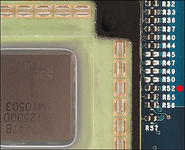
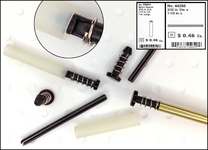
 macos9lives.com
macos9lives.com






